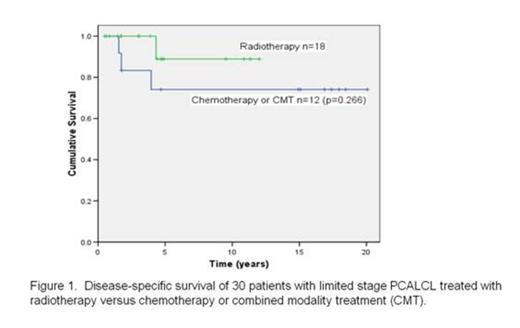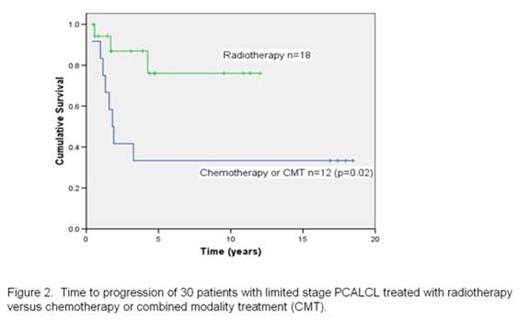Abstract
Background: Primary cutaneous anaplastic large cell lymphoma (PCALCL) is a rare T-cell cutaneous lymphoma consisting of CD30 positive typically anaplastic-appearing cells and was distinguished from systemic ALCL and lymphomatoid papulosis in the World Health Organization classification of lymphoid neoplasms. Previous studies have shown PCALCL has an excellent overall survival with few patients dying from disease. Over-treatment should be avoided.
Methods: The British Columbia Cancer Agency Lymphoid Cancer Database was searched to identify all adults (>18 years) diagnosed with PCALCL from 1993 to 2013 with complete clinical information. Pathologic records were reviewed to confirm the diagnosis and correlate with presenting clinical features. Before 2005, patients with limited stage disease commonly received combined modality therapy using CHOP-like chemotherapy. After 2005, the Lymphoma Tumor Group endorsed treatment with radiotherapy (RT) alone due to emerging data failing to support a role for chemotherapy.
Results: 46 patients (31 males (67%); M:F ratio 2) with a median age of 64 y were identified (Table 1). 39 patients had limited stage disease (stage 1A, n=38; stage 2A n=1) and 7 patients had advanced stage disease (multiple distant cutaneous sites). For the limited stage patients 18 were treated with radiotherapy (RT) alone, 8 with combined modality therapy (CMT) consisting of CHOP-like chemotherapy for 3 cycles followed by involved field RT, 4 with chemotherapy alone, 5 with surgical resection alone and 4 patients refused or were too frail to be treated due to unrelated comorbidities. For the 7 patients with advanced stage disease, 2 received local therapy alone (RT n=2; surgery n=1) and 4 received CHOP-like chemotherapy. The median follow-up for living patients was 54.5 months (range 4 to 241 months). Overall, 18 (39%) patients relapsed, of which, only 2 (11%) had progressed to advanced stage at first relapse. The majority of relapses were cutaneous; however, 4 patients ultimately developed systemic disease with biopsy proven ALK-negative ALCL. 4 patients (9%) died from PCALCL and none had had advanced stage disease at diagnosis. For the whole cohort, the 5-y time to progression (TTP) was 53% (59% for limited stage and 21% for advanced stage patients), the 5-y disease specific survival (DSS) was 83% and the 5-y overall survival (OS) was 73%. In an as-treated analysis, the 5-y DSS for limited stage patients was similar comparing RT to CMT or CHOP-like chemotherapy alone (Figure 1) but the 5-y TTP for limited stage patients favored RT alone compared to CMT or CHOP-like chemotherapy (76% vs 33%, p=0.02)(Figure 2). Furthermore, limited stage patients treated after the 2005 policy change endorsing RT alone had a similar TTP compared to patients treated prior to 2005 (5-y TTP 61% vs 50%, respectively, p= 0.860). The 5-y DSS and OS rates for all patients with limited stage disease were 80% and 68%, respectively. For all patients, the five year risk of systemic recurrence was 9%.
Conclusion: Limited stage is typical of PCALCL and few patients present with advanced disease. We confirm the favorable prognosis in PCALCL and the effectiveness of RT alone, without systemic treatment, at minimizing the risk of relapse. A small proportion of patients developed systemic ALCL. Stage at diagnosis did not predict the rare event of death in this series.
Patient characteristics and clinical follow-up
| Characteristic . | . | N (%) . |
|---|---|---|
| Total | 46 (100%) | |
| Gender | Males | 31 (67%) |
| Stage at diagnosis | I/II | 39 (85%) |
| IV | 7 (15%) | |
| Initial treatment | Radiotherapy (RT) alone | 20 (44%) |
| CHOP-like + RT | 8 (17%) | |
| CHOP-like | 8 (17%) | |
| Surgery | 6 (13%) | |
| Refused | 1 (2%) | |
| Too frail | 3 (7%) | |
| Response rate | Complete | 40 (87%) |
| Partial | 5 (11%) | |
| Uncertain | 1 (2%) | |
| Site of first relapse | Skin only | 14 (78%) |
| Regional lymph node | 0 (0%) | |
| Systemic* | 4 (22%) | |
| Follow-up (months) | Median (range) | 54.5 (4 to 241) |
| Status at last follow-up | No evidence of disease | 28 (61%) |
| Alive with disease | 6 (13%) | |
| Died of lymphoma | 4 (9%) | |
| Died of other cause | 9 (19.5%) | |
| Disease-specific survival | 5 y (all patients) | (83%) |
| Overall survival | 5 y (all patients) | (73%) |
| Progression-free survival | 5 y (all patients) | (42%) |
| Characteristic . | . | N (%) . |
|---|---|---|
| Total | 46 (100%) | |
| Gender | Males | 31 (67%) |
| Stage at diagnosis | I/II | 39 (85%) |
| IV | 7 (15%) | |
| Initial treatment | Radiotherapy (RT) alone | 20 (44%) |
| CHOP-like + RT | 8 (17%) | |
| CHOP-like | 8 (17%) | |
| Surgery | 6 (13%) | |
| Refused | 1 (2%) | |
| Too frail | 3 (7%) | |
| Response rate | Complete | 40 (87%) |
| Partial | 5 (11%) | |
| Uncertain | 1 (2%) | |
| Site of first relapse | Skin only | 14 (78%) |
| Regional lymph node | 0 (0%) | |
| Systemic* | 4 (22%) | |
| Follow-up (months) | Median (range) | 54.5 (4 to 241) |
| Status at last follow-up | No evidence of disease | 28 (61%) |
| Alive with disease | 6 (13%) | |
| Died of lymphoma | 4 (9%) | |
| Died of other cause | 9 (19.5%) | |
| Disease-specific survival | 5 y (all patients) | (83%) |
| Overall survival | 5 y (all patients) | (73%) |
| Progression-free survival | 5 y (all patients) | (42%) |
* Two patients initially relapsing in the skin subsequently developed a systemic relapse.
No relevant conflicts of interest to declare.
Author notes
Asterisk with author names denotes non-ASH members.



This feature is available to Subscribers Only
Sign In or Create an Account Close Modal